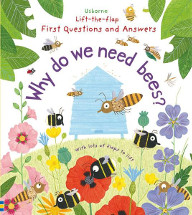Why do we need bees? Katie Daynes

Ill. by Christine Pym. Usborne, 2017. ISBN 9781474917933
Type the title of this book into a search engine and you instantly
get millions of results including this video, such is the
importance of this tiny creature to the welfare of the world. For
without bees to pollinate the plants there are no plants and
therefore no food to sustain people or animals.
So it makes sense to make our very youngest scientists and botanists
aware of the critical need to protect these creatures as they carry
out their important work and this new release in the Usborne
Lift-the-Flap series does just this.
Using the question-and-answer format that little children themselves
use and which lays the foundations for inquiry-based learning, the
role of bees is explored in six double page spreads. Each
starts with a key question such as what are bees?; why do we need
bees?; and where do bees live? and this is then supported by a more
focused question, the answer to which is hidden under a flap.
Delicately illustrated but sturdily constructed as a board book,
each page offers much to explore and learn, with both the questions
and answers in simple sentences and vocabulary that young readers
understand. And for those who want to know more Usborne Quicklinks
supplies vetted weblinks
to satisfy.
Children are curious about the world around them and we know that as
parents and teachers we can't always answer all their
questions. Helping them understand that there is information
to be found in books and their questions can be answered is a first
step in the development of their information literacy, and learning
that you can dip and delve into books as your interest is piqued and
that you can readily return to what you discover is invaluable.
Even though this is a lift-the-flap book, a format normally
associated with the very young, it contains a way into non fiction
that is perfect for early childhood and could serve as a model for
presentation for older students required to investigate the world
around them as they learn to pose questions as well as answer them
succinctly. An interesting way to introduce keywords,
note-taking, summarising, paraphrasing and using your own words!
A book that has riches beyond those given to us by its subject!
Barbara Braxton